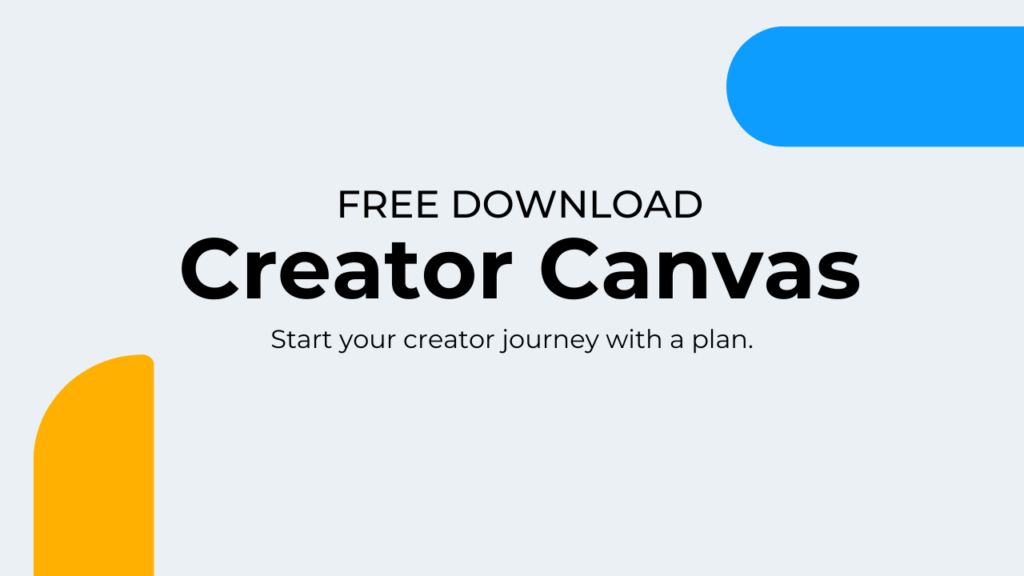
What Do Businesses Think of the Creator Economy (and how you can position yourself to earn from it)
As a content creator, there are numerous ways to make money: through sales of goods and services, through sales of courses, and through sponsored content.
Many content creators build on their passions: through blogging, course creation, and designing merchandise to go with their brand. Sponsored content is another great way to increase your revenue.
With a little bit of know-how, some statistics to back up your pitch, and some outreach, you will be well on your way to earning more and creating relationships that will continue to pay off.
How Does the Creator Economy Work?
The Creator Economy is the provision of content (education, entertainment, and information) presented through the web and web app platforms to the general public. According to Signalfire, the Creator Economy is built of “over 50 million independent content creators, curators, and community builders including social media influencers, bloggers, and videographers, plus the software and finance tools designed to help them with growth and monetization.”
Creators
Creators are the backbone of the Creator Economy. Creators provide the content that the public loves to consume. From dances on TikTok to photos on Instagram, tutorials on YouTube (and everything in between), Creators give us all a reason to scroll, to learn, to pass time, and to be entertained.
Creative content will always be wanted and will continue to be a demand. Creators bring that to the public.
Consumers
Think of consumers as a creator’s customers. On most platforms, consumers don’t pay for content. Consumers vote with their thumbs – by scrolling quickly, or stopping on a creator’s account to partake of their content.
Although consumers may not directly pay for the content they enjoy, they are often influenced by content creators to make purchases or goods that are either blatantly being shared, or subtly present.
Throughout 2020-2021, TikTok creators began displaying The Coldest™ water bottles in their 60-second videos. Although the company has not shared their sales as a result of this product placement, based on the longevity of the product placement, and the number of content creators involved, one can assume that there was, at least, modest success – if not existential growth. A quick internet search for the product reveals pages and pages of reviews and sales opportunities.
Consumers can be influenced by creators they follow and admire.
Platforms
Platforms for content creation come and go – or come and stay. Vine, for example, was an American short-form video hosting service where users could share six-second-long, looping video clips. (Wikipedia.) Vine was short-lived. Other social sharing platforms (like Facebook, YouTube, Instagram, Snapchat, and TikTok) have survived.
Platforms provide creators a place to share their content, and a built-in audience to consume it.
Businesses
In the Creator Economy, businesses can be any one of several contributors. Creators themselves can grow to be businesses. Social sharing platforms are certainly businesses. But what we want to focus on here is businesses as content sponsors.
Businesses (like The Coldest™ mentioned above) seek out content creators as influencers to partner with through product placement or endorsement.
Content sponsorship is part of a business’s advertising strategy. Get influencers to use and share your products so that their audiences will become your customers.

The Creator Business Model
As you can see from our definitions above, the relationships between content creators, their platforms, and business sponsors have the potential to provide revenue for content creators. There are several ways that this can happen.
Platform Revenue Sharing
Often called “creator funds,” platforms pay more popular creators to continue to produce content. Because creators like these are driving usage of their platforms, social media giants like Facebook, Instagram, Pinterest, Twitter, and yes, TikTok, pay creators to keep the traffic coming.
Advertisers pay platforms for ad space and air time. (How many times have you sat through 5- or 15- second ads on YouTube to be able to see a video?) Platforms rely on creators for traffic. So having content that drives traffic is worth investing in. That’s where you, the content creator, comes in.
Platforms are ready to pay you for content that provides something (information, education, entertainment).
Affiliate Marketing
Content creators have been part of affiliate marketing since social sharing began. Armed with affiliate links, bloggers, YouTubers, Facebookers and more share about products and services that they use within their content, then share their affiliate links for followers to use for purchases.
Affiliate marketing (like product and brand placement below) works because followers assume that the content provider both uses and endorses what they are sharing. Often termed “social proof,” endorsements and reviews help consumers make purchase decisions based on trust.
Product Placement
Like the Coldest Water™ example before, product placement is usually subtle. (With this example, TikTok users simply had the signature bright blue bottle somewhere within the video.)
Product placement also implies endorsement by the content creator. If you see someone you admire using a product, you assume they like it – and extrapolate that you will, too.
According to an article by Elite Daily, platform users become obsessed with products that they’ve discovered through influencer use. From skin care products to food storage containers, product placement works.
Brand Sponsorship
Brands sponsor content. Whether you’re providing a newsletter, video, podcast episodes, blog posts, and yes, even courses, brands will pay you to sponsor your content.
Many TikTok creators’ entire accounts are dedicated to Amazon “finds” that they want you to buy and try. And in many cases, those products can sell out simply through these endorsements. Sponsored content is a win/win for both the brand and you.
Most often, brands look to sponsor content that is in relation to the products and services they offer, but that isn’t always the case. Larger brands, like Coca~Cola, for example, sponsor events and content simply because they see an opportunity for sales, and the content will be seen by many. One of Coke’s most famous commercials was a football player “Mean Joe Green” drinking a Coca~Cola at a football game. Athletes seldom consume beverages like that at sporting events, but this commercial hit the mark with consumers, and is still referenced over 40 years later.
Most brands, however, will look to sponsor content that is in alignment with their products and services. If you offer online courses in photography, for example, you might seek out sponsorships from photography-related goods and services like photo sharing sites for professional photographers, cameras, and photography equipment.
Courses offering cooking and recipe content might find sponsors in the makers of cooking utensils, food preparation appliances, and food brands.
The more closely aligned with your content a brand is, and the bigger your audience, the more likely a brand is to say yes to sponsorship opportunities.
Working with Sponsors to Monetize Your Content
Although sponsors may approach you to work with you, it’s more likely that (at least when you’re first getting started) you will have to reach out to potential sponsors. There are things you will want to have prepared before you do that, so that you can present your offerings professionally, and be equipped to answer questions that they have.
Develop Your Sponsorship Offerings
First, decide what your sponsorship offerings will be, and how much you want to charge for the sponsorships. Think about all the content you provide, how frequently you publish, and then how much you want to set the fees for that.
Some content to include in sponsorships:
- Main site
- Courses
- Lessons
- Blog posts
- Newsletters
- Podcast episodes
- Social media posts
Define the duration of the sponsored content:
- Per blog post
- Per social post
- Per course/lesson
- Per newsletter
- Per podcast episode
- Or for a set period of time: weekly, monthly, annually
Create a page on your site (or a downloadable PDF) outlining the sponsorship opportunities. You can then direct marketing efforts to this page, and any inquiries you receive.
Create a Media Kit
Your media kit is a place to really shine! It should include all of the necessary elements that showcase your brand. It can include information from your About Us page, but shouldn’t be as much a narrative as easily digestible information nuggets. Short paragraphs and bullet points are great in a media kit.
Be sure to include:
- Brand statistics
- How many students take your courses
- How many site visitors you have
- Number of newsletter subscribers
- Podcast listenership
- Course information (how many courses? How many lessons?)
- Audience demographics
- Social media following per platform
- Brand information
- Logo
- Tag line
- Testimonials
- Timeline of when you started to where you are now, showing growth
A good media kit will help potential sponsors decide whether your brand is a good fit for them, and where they would like to direct their sponsorship money.
Develop a List of Potential Advertisers
Spend some time creating a list of potential sponsors/advertisers. Use a spreadsheet to add their site, email address (or contact page), person to contact (if you have one), phone number, and any other pertinent information.
Create an email to send to potential advertisers (or to use in the body of their contact form) outlining who you are, the brand you’ve created, and the sponsorship opportunities you’re relaying. (You can also use this loosely as a script for phone calling potential sponsors.)
Make notes in a column of your spreadsheet of the date of your outreach, and then any additional conversations you have with sponsors and the outcome.
Keeping all of this information in one place will help you streamline your outreach, and ensure that you’re not missing out on any potential opportunities.
The Future of the Creator Economy
From the invention of the printing press, to the latest social platforms and the ability to publish anything you want to online, content continues to be consumed in huge quantities.
As younger generations rise up, their use of technology for creating a self-managed living grows. Creativity and understanding the different ways content creates revenue has made it possible for nomadic living (van life, DIY, and bicycling, to name a few), funding dreams (like small sustainable farms, tiny homes, and photography), and supplementing day jobs with more passive income (like sponsored content, e-commerce merchandise), and course creation).
The future is content, and you’re on the precipice of doing something amazing (and getting paid for it).
Download our creator business canvas template to build your own path to financial sustainability by creating content that matches your passion!


Michelle Frechette
@LearnDashLMS






